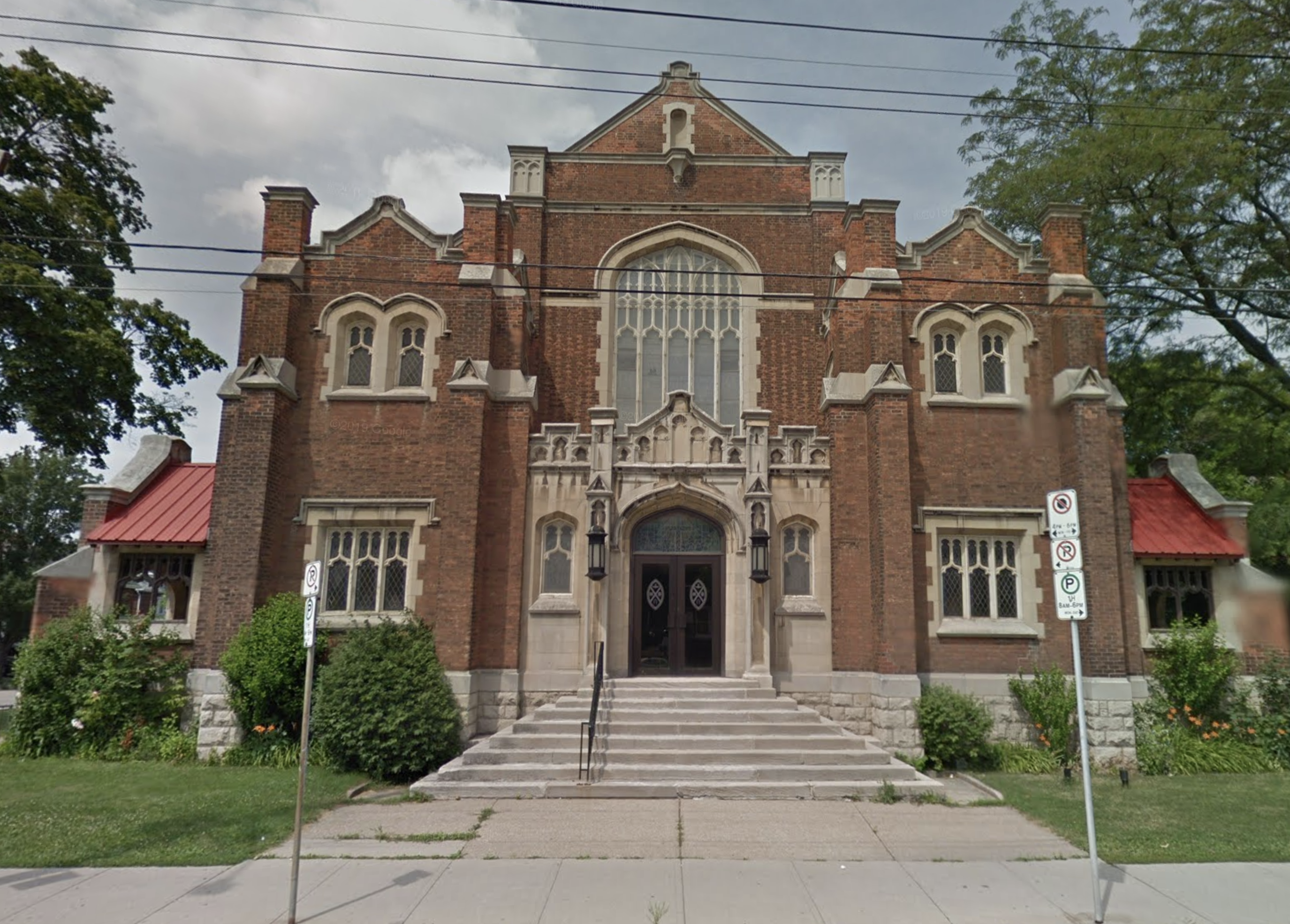The future of a former United church in Hamilton, Ont. is uncertain after plans to demolish it were put on hold.
St. Giles, a sprawling, early 20th-century church in the city’s Gibson neighbourhood, has been the focus of controversy ever since the owners, another United Church congregation, requested a demolition permit in 2018.
You may unsubscribe from any of our newsletters at any time.
New Vision United wants to build roughly 90 units of affordable and market-rate rental housing on the site, with about a third being affordable, pointing to the need for affordable options in the city. But the plan to knock down the structure angered local advocates, who argue it has historic value and want it incorporated into any new development.
“There’s a lot of people who have been saying we don’t have a lot of fine architecture in this area, and since 2018, New Vision has kind of been making us fight for it,” says Sarah Sheehan, a heritage advocate and an unofficial spokesperson for a new community group called Friends of St. Giles, which she says includes some former congregants.
“Since February, we’ve made our position very clear that we continue to support housing and a collaborative approach to adaptive reuse as the healthiest, greenest and most appropriate option for a building of this calibre.” Advocates also want the original 1912 section to be designated as a heritage building.
Hamilton’s city council voted earlier this month to send the matter back to the planning committee, to allow the local ward councillor to work with the owner to look at options for the property that include adapting the current building for housing purposes.
New Vision, a merger of two former churches, St. Giles United and Centenary United, has worshipped in Centenary United’s building since 2015 while the congregation decides what to do with the St. Giles property. Last year, New Vision began working with the United Property Resource Corporation (UPRC), a corporation that The United Church of Canada created to help faith communities turn their properties into affordable homes.
More on Broadview:
- 9,000 faith properties could close soon. Jordana Wright has an idea to save them.
- What to do with your grief when a church closes
- New development corporation to keep real estate in the United Church
“UPRC’s commitment is to responsibly explore options for heritage conservation and we understand and appreciate the concerns of the community,” Tim Blair, the CEO of UPRC, said in a statement. “Our intent is to come forward with options for the community to discuss, provide input and prioritize.”
Dixon Challoner, the chair of New Vision’s council, says that the UPRC has engaged “excellent architects,” but that there are “significant structural issues” with the building, as well as a slight slope to the sanctuary floor, that would make repurposing the building especially challenging.
In 2014, St. Giles was faced with nearly $1 million in deferred maintenance costs, he says. The UPRC cites a structural assessment that concluded the building was structurally compromised and that in UPRC’s opinion, a large residential tower with above-market rents would have to be built to offset the cost of restoring St. Giles.
Challoner defends the church’s approach, saying that when New Vision began, they opted to focus less on buildings in their ministry, as well as make affordable housing a priority.
“[We thought], we don’t want to do another mend-the-roof fundraiser, that’s not the kind of way that as a faith community we want to be spending resources,” he says.
Over 2,100 signatures on the petition to #SaveStGiles! ?
Please take a moment to sign if you haven’t already ?
Our best #architecture is not a bargaining chip:
Tell our leaders we deserve #HousingANDHeritage
?️⛪️?
#OurWard3 #ClimateAction #HamOnthttps://t.co/dPaS4G04GX— Friends of St. Giles ? #SaveStGiles (@StGilesFriends) April 19, 2021
But he says that the congregation initially hoped to save St. Giles.
“Our first attempts working with private developers were to find a way of building housing into the existing envelope of the 1912 structure, but it’s one thing to have the concept — it’s another thing to execute that in practical terms,” he says.
He adds that the multi-year process of trying to find a solution has been stressful for members, with many hours of volunteer time.
“It’s not something that anyone has taken lightly,” he says.
Sheehan says she’s frustrated by what she sees as a lack of communication between the church and community members, citing the church withdrawing a demolition permit in April, only to have congregants write an op-ed mentioning demolition later published in the Hamilton Spectator.
“The congregation members, they are making it a little difficult, I think probably for the councillor as well as for us, to trust this three-option proposal when all they’ll talk about is demolition,” she says.
She’s also not convinced that the church is structurally unsound.
“A couple of us have been in touch with the National Trust for Canada, and their person that we spoke with indicated that engineering reports tend to favour the client, and we’d like to see an independent report,” she says.
The executive director of Indwell, a Christian affordable housing organization, told the Hamilton Spectator last week that he was interested in partnering with New Vision on a plan to adapt the building, citing Indwell’s experience on a previous project.
Challoner says the congregation would love to see the church preserved if the plan wouldn’t compromise the affordability of planned housing and would be appropriate for the neighbourhood.
“It’s not as if anyone at New Vision has any sort of antipathy towards the current building, the St. Giles building, it’s not like we want to take it down,” he says. “Obviously, we would be thrilled.”
EDITOR’S NOTE: This story was updated on May 4, 2021 to note the portion of a proposed housing development that New Vision United hopes to make affordable, as well as to qualify that the 90-unit number is an approximate one.
***
Emma Prestwich is Broadview’s digital editor.
















I sometimes find irony in these stories. No one wants to support these buildings or attend them, but as soon as we no longer need them, they are a necessity of the neighbourhood.
Still, there is no one willing to pitch in to save it.
Talk about hypocrisy of Christians. The “neighbourhood” doesn’t want Christianity, but desperately will do anything to support their NIMBY syndrome.